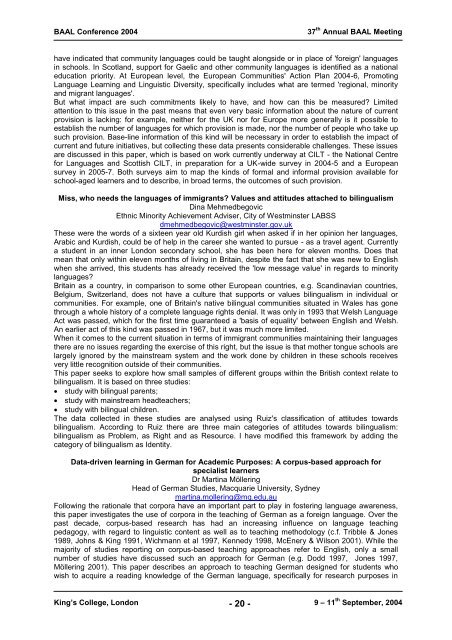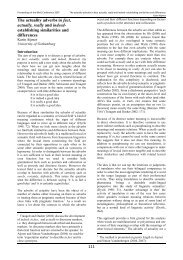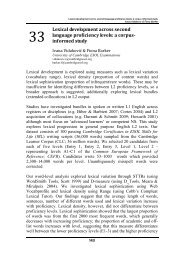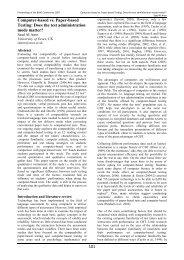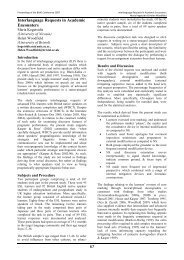Colloquia - British Association for Applied Linguistics
Colloquia - British Association for Applied Linguistics
Colloquia - British Association for Applied Linguistics
Create successful ePaper yourself
Turn your PDF publications into a flip-book with our unique Google optimized e-Paper software.
BAAL Conference 2004 37 th Annual BAAL Meeting<br />
have indicated that community languages could be taught alongside or in place of '<strong>for</strong>eign' languages<br />
in schools. In Scotland, support <strong>for</strong> Gaelic and other community languages is identified as a national<br />
education priority. At European level, the European Communities' Action Plan 2004-6, Promoting<br />
Language Learning and Linguistic Diversity, specifically includes what are termed 'regional, minority<br />
and migrant languages'.<br />
But what impact are such commitments likely to have, and how can this be measured? Limited<br />
attention to this issue in the past means that even very basic in<strong>for</strong>mation about the nature of current<br />
provision is lacking: <strong>for</strong> example, neither <strong>for</strong> the UK nor <strong>for</strong> Europe more generally is it possible to<br />
establish the number of languages <strong>for</strong> which provision is made, nor the number of people who take up<br />
such provision. Base-line in<strong>for</strong>mation of this kind will be necessary in order to establish the impact of<br />
current and future initiatives, but collecting these data presents considerable challenges. These issues<br />
are discussed in this paper, which is based on work currently underway at CILT - the National Centre<br />
<strong>for</strong> Languages and Scottish CILT, in preparation <strong>for</strong> a UK-wide survey in 2004-5 and a European<br />
survey in 2005-7. Both surveys aim to map the kinds of <strong>for</strong>mal and in<strong>for</strong>mal provision available <strong>for</strong><br />
school-aged learners and to describe, in broad terms, the outcomes of such provision.<br />
Miss, who needs the languages of immigrants? Values and attitudes attached to bilingualism<br />
Dina Mehmedbegovic<br />
Ethnic Minority Achievement Adviser, City of Westminster LABSS<br />
dmehmedbegovic@westminster.gov.uk<br />
These were the words of a sixteen year old Kurdish girl when asked if in her opinion her languages,<br />
Arabic and Kurdish, could be of help in the career she wanted to pursue - as a travel agent. Currently<br />
a student in an inner London secondary school, she has been here <strong>for</strong> eleven months. Does that<br />
mean that only within eleven months of living in Britain, despite the fact that she was new to English<br />
when she arrived, this students has already received the 'low message value' in regards to minority<br />
languages?<br />
Britain as a country, in comparison to some other European countries, e.g. Scandinavian countries,<br />
Belgium, Switzerland, does not have a culture that supports or values bilingualism in individual or<br />
communities. For example, one of Britain's native bilingual communities situated in Wales has gone<br />
through a whole history of a complete language rights denial. It was only in 1993 that Welsh Language<br />
Act was passed, which <strong>for</strong> the first time guaranteed a 'basis of equality' between English and Welsh.<br />
An earlier act of this kind was passed in 1967, but it was much more limited.<br />
When it comes to the current situation in terms of immigrant communities maintaining their languages<br />
there are no issues regarding the exercise of this right, but the issue is that mother tongue schools are<br />
largely ignored by the mainstream system and the work done by children in these schools receives<br />
very little recognition outside of their communities.<br />
This paper seeks to explore how small samples of different groups within the <strong>British</strong> context relate to<br />
bilingualism. It is based on three studies:<br />
� study with bilingual parents;<br />
� study with mainstream headteachers;<br />
� study with bilingual children.<br />
The data collected in these studies are analysed using Ruiz's classification of attitudes towards<br />
bilingualism. According to Ruiz there are three main categories of attitudes towards bilingualism:<br />
bilingualism as Problem, as Right and as Resource. I have modified this framework by adding the<br />
category of bilingualism as Identity.<br />
Data-driven learning in German <strong>for</strong> Academic Purposes: A corpus-based approach <strong>for</strong><br />
specialist learners<br />
Dr Martina Möllering<br />
Head of German Studies, Macquarie University, Sydney<br />
martina.mollering@mq.edu.au<br />
Following the rationale that corpora have an important part to play in fostering language awareness,<br />
this paper investigates the use of corpora in the teaching of German as a <strong>for</strong>eign language. Over the<br />
past decade, corpus-based research has had an increasing influence on language teaching<br />
pedagogy, with regard to linguistic content as well as to teaching methodology (c.f. Tribble & Jones<br />
1989, Johns & King 1991, Wichmann et al 1997, Kennedy 1998, McEnery & Wilson 2001). While the<br />
majority of studies reporting on corpus-based teaching approaches refer to English, only a small<br />
number of studies have discussed such an approach <strong>for</strong> German (e.g. Dodd 1997, Jones 1997,<br />
Möllering 2001). This paper describes an approach to teaching German designed <strong>for</strong> students who<br />
wish to acquire a reading knowledge of the German language, specifically <strong>for</strong> research purposes in<br />
King‟s College, London 9 – 11 th - 20 -<br />
September, 2004


